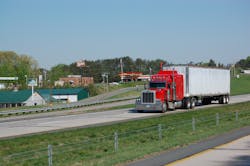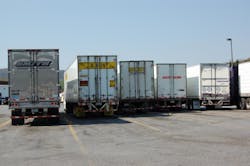Current freight volume levels may be more “normalized” than many in the trucking industry might suspect, according to data tracking by load matching service Truckstop.com.
In a conference call hosted by research firm Stifel Capital Markets, Paris Cole, CEO of Truckstop.com, also noted that based on his company’s enhanced Rate Analysis tool, freight rates for motor carriers are projected to move upwards through next year.
“We see a tightening in demand [and] generally speaking we see rates improving thru 2017,” he explained on the call. “There are a numbers of factors that can influence [rate increases] but generally, we see rates going up.”
Cole added that, based on analysis of the loads posted to the Truckstop.com site over the last several years, freight is far more “normalized” in terms of volume – especially when 2014’s numbers are removed from the mix.
“Load volume decreased dramatically between 2014 and 2015. But if you exclude those years, volumes in 2016 are ‘normalized’ especially when compared to 2013 and earlier,” he emphasized.Based on Truckstop.com data, Cole said freight volumes are down 8% in 2016 compared to 2013 but up 2% compared to 2012 and up 11% versus 2011. Compared to recent years, volumes are down 38% in 2016 versus 2014 and down 3% versus 2015.
In terms of freight rates, he noted that rates are down “across all equipment types” this year – dry van, flatbed, and refrigerated – except in five states: Rhode Island, Vermont, Georgia, New Mexico, and Arizona. “We’re not sure we’ve hit the bottom yet,” Cole added.
However, he stressed that in terms of volumes, there’s been a lot of activity in certain freight niches – especially in the “specialty freight” market that includes oversize and over-dimensional cargo as well as tanker operations.
“In terms of specialty freight, if you look at year-over-year volumes, in 2016 it’s down 11% but up 4% versus 2014 and up 52% and 44% compared to 2013 and 2012, respectively,” Cole pointed out.
Cole also noted significant change is occurring in terms of how brokers and motor carriers use the spot market, especially over the last five years:
- When Truckstop.com started out, freight typically got posted for same day pickup. “Now last in the last five years that’s changed dramatically: over half of loads the posted on our site today are one day or more in advance of the pickup date,” he said. “To us that means the spot market is being used more as a planning tool and less as a last area of resort to move freight.”
- Motor carriers used to use the spot market primarily to search for backhauls. “Now, 80% of their searches are for ‘front hauls’ or to reposition equipment,” Cole said. “No longer are they using just for backhauls; again, they are using the spot market as a planning tool and [as] a significant source of revenue.”
- The company noticed in recent years that certain economic “nodes” develop from time to time in the U.S. in the economy. The question is: How do they affect overall freight volumes? “For example, if there is a flood in Louisiana, what does it do to rest of economy? Is there a ripple effect of freight from that ‘node’? That is something we’re looking into with future analysis.”
- Cole views the stock market as an “evolution path” for the freight spot market. “Having an electronic [stock] exchange reduced the ‘bid/ask’ spread on securities. So we’ve see variability in the [stock] prices decrease in the market,” he explained. “Now, ask 10 [freight] brokers for a flatbed rate to Chicago, and I’m confident you’d get 10 very different answers with huge variability [in their rates]. So the less variability there is with rates, the more we can ‘speed up’ the movement of freight. If you trust your [rate] information more, there is less need for negotiation.”
- Freight hedging is going to develop at some point in the future, but the trucking industry is not there yet. “From a technology perspective we can produce something. But the willingness of the industry to adopt it requires a tremendous learning curve and behavioral shift, before they adopt it with any kind of scale,” Cole explained. “We’re just not hearing the need for that [freight hedging] from customers today. But as the level of sophistication improves – as carriers get more comfortable with derivatives – I am sure we’ll see that product.”
About the Author
Sean Kilcarr
Editor in Chief
Sean Kilcarr is a former longtime FleetOwner senior editor who wrote for the publication from 2000 to 2018. He served as editor-in-chief from 2017 to 2018.

